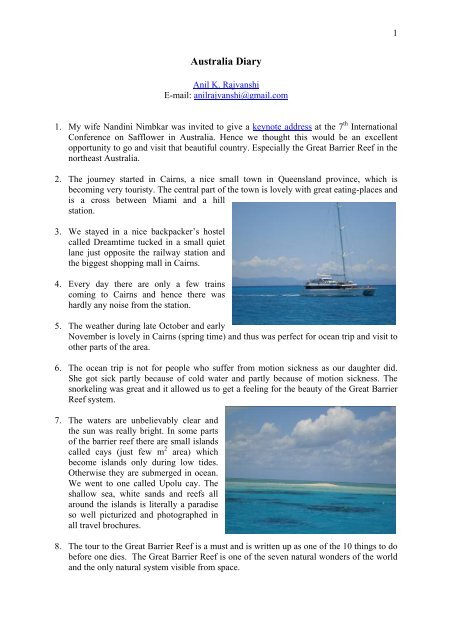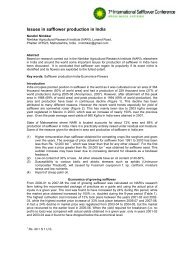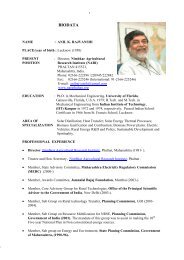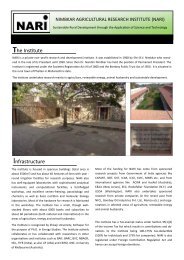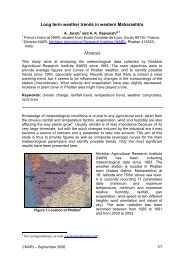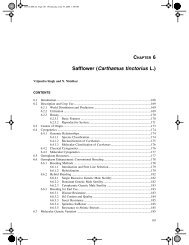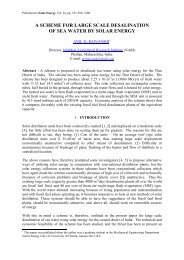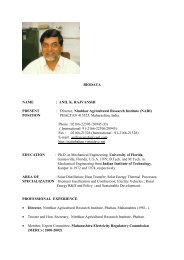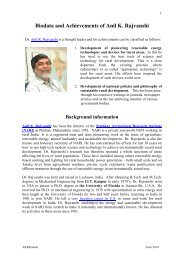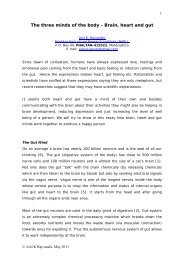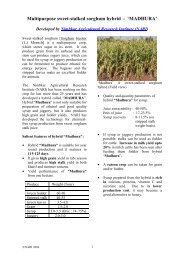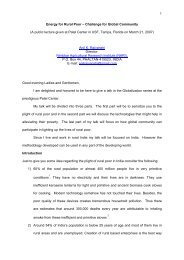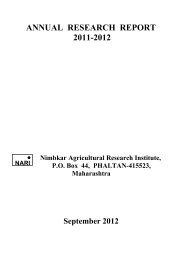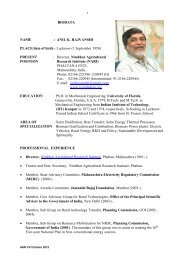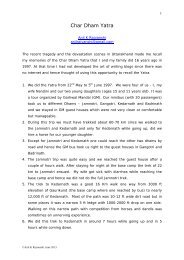Australia Diary - NARI
Australia Diary - NARI
Australia Diary - NARI
You also want an ePaper? Increase the reach of your titles
YUMPU automatically turns print PDFs into web optimized ePapers that Google loves.
1<br />
<strong>Australia</strong> <strong>Diary</strong><br />
Anil K. Rajvanshi<br />
E-mail: anilrajvanshi@gmail.com<br />
1. My wife Nandini Nimbkar was invited to give a keynote address at the 7 th International<br />
Conference on Safflower in <strong>Australia</strong>. Hence we thought this would be an excellent<br />
opportunity to go and visit that beautiful country. Especially the Great Barrier Reef in the<br />
northeast <strong>Australia</strong>.<br />
2. The journey started in Cairns, a nice small town in Queensland province, which is<br />
becoming very touristy. The central part of the town is lovely with great eating-places and<br />
is a cross between Miami and a hill<br />
station.<br />
3. We stayed in a nice backpacker’s hostel<br />
called Dreamtime tucked in a small quiet<br />
lane just opposite the railway station and<br />
the biggest shopping mall in Cairns.<br />
4. Every day there are only a few trains<br />
coming to Cairns and hence there was<br />
hardly any noise from the station.<br />
5. The weather during late October and early<br />
November is lovely in Cairns (spring time) and thus was perfect for ocean trip and visit to<br />
other parts of the area.<br />
6. The ocean trip is not for people who suffer from motion sickness as our daughter did.<br />
She got sick partly because of cold water and partly because of motion sickness. The<br />
snorkeling was great and it allowed us to get a feeling for the beauty of the Great Barrier<br />
Reef system.<br />
7. The waters are unbelievably clear and<br />
the sun was really bright. In some parts<br />
of the barrier reef there are small islands<br />
called cays (just few m 2 area) which<br />
become islands only during low tides.<br />
Otherwise they are submerged in ocean.<br />
We went to one called Upolu cay. The<br />
shallow sea, white sands and reefs all<br />
around the islands is literally a paradise<br />
so well picturized and photographed in<br />
all travel brochures.<br />
8. The tour to the Great Barrier Reef is a must and is written up as one of the 10 things to do<br />
before one dies. The Great Barrier Reef is one of the seven natural wonders of the world<br />
and the only natural system visible from space.
2<br />
9. Northeast part of <strong>Australia</strong> called Daintree Rainforest is a lush tropical area with massive<br />
rainfall and is the World Heritage Site. It is supposed to be the oldest rainforest in the<br />
world. Hence besides the Great Barrier Reef it is also wonderful to visit this area. Part of<br />
it has been cut and converted into agricultural land. Still some places have been left<br />
untouched and these we visited. The other areas where the forest has been cleared are<br />
used for growing sugarcane, fruits and other cash crops.<br />
10. Because of high rainfall the rain forest<br />
almost touches the sea in Cape<br />
Tribulation, a lovely small town with<br />
beautiful beaches. Being remote it is still<br />
relatively underdeveloped.<br />
11. The electricity situation in the Cape is pretty<br />
grim. It is just like some parts of India where<br />
they get 3-4 hours of electricity. Mostly<br />
diesel-powered generators provide electricity<br />
to shops and hotels. With so much biomass<br />
they should be able to produce good amount<br />
of electricity. Instead they are going for solar PV systems which might not work since 4-5<br />
months of the year (monsoons) there is no sun. Nevertheless with small towns dotting<br />
this area and with not too much development it is a nature lover’s paradise with enormous<br />
diversity of flora and fauna.<br />
12. We also visited Atherton tablelands – a raised area<br />
below Cairns which is the Southern part of Daintree<br />
Forest. This area is very productive and is the food<br />
basket of <strong>Australia</strong>. The whole tableland and the<br />
Daintree rain forest needs at least a month to<br />
thoroughly explore it. There are hundreds of waterfalls<br />
and rapids. Hence our 4-day trip was wholly inadequate<br />
to see the wonderful nature. Nevertheless this visit to<br />
some of the well known waterfalls provided us a<br />
glimpse and a sense of the beauty of the area.<br />
13. The birds in this part<br />
of <strong>Australia</strong> are very<br />
colourful, big and<br />
with huge repertoire of songs. Thus it is a veritable bird<br />
lovers’ paradise. They are fed continuously by tourists<br />
and so have become bold and used to their presence.<br />
On a visit to Botanical Garden in Cairns I was sitting<br />
on a bench when a blackbird brought in a grasshopper<br />
in its beak and put it in front of me probably thinking<br />
that I will offer it a piece of bread ! Immediately a kookaburra flew in and grabbed the
3<br />
grasshopper. Thereafter a big fight ensued between the two birds which was worth<br />
watching and quite hilarious. Similarly during one of our picnic lunches a sunbird came<br />
and ate a piece of bread from our plate. It would not touch any meat or salad!<br />
14. On all our trips we saw a large number of girls traveling individually or in groups in most<br />
of these places. There were relatively few males. Probably it is very safe for girls to travel<br />
in <strong>Australia</strong> and partly this is the era of female power!<br />
15. There is tremendous amount of smoking among young girls in <strong>Australia</strong> and hence it is<br />
difficult to sit in public places because of this pollution. Older <strong>Australia</strong>n generation also<br />
complain about the younger generation’s penchant for drinking. It is a major problem<br />
among <strong>Australia</strong>n teenagers.<br />
16. We visited Sydney for 3-4 days and stayed in center of Sydney and close to Opera House.<br />
It is a lovely compact city to visit for few days, but quite expensive to live in. The usual<br />
touristy places of Harbor Bridge, Darling Harbour, Sydney Opera House and Bondi<br />
Beach are worth visiting. With cool clear nights it was a lovely city and a visitors’<br />
delight. Sydney also has a very large<br />
Chinese and Indian population.<br />
17. <strong>Australia</strong>ns are very friendly people.<br />
For example whenever we seemed to<br />
be lost and were looking for directions<br />
in our maps somebody or other would<br />
come to help us without our asking.<br />
Such a thing is unheard of in US or<br />
other European countries.<br />
18. Wagga Wagga where the conference<br />
was taking place is a nice small town<br />
in New South Wales province. With its population of about 60,000 it is a big city<br />
according to <strong>Australia</strong>n standards but small according to Indians. The main industry is<br />
agriculture though few light industries are coming along. Wagga Wagga is an aborigine<br />
word for many crows. In aborigine language the plural is always denoted by repeating<br />
the word.<br />
19. The train journey from Sydney to Wagga Wagga takes around 6 hours. With high-speed<br />
trains it should not take more than 2-2½ hours. The train system in <strong>Australia</strong> emulates the<br />
American one and thus most of the people travel by car. Nevertheless the journey was<br />
beautiful and it went through Blue Mountain region and ended with parched tableland of<br />
Wagga Wagga.<br />
20. Because of recent drought in most of <strong>Australia</strong> the lands around Wagga Wagga were<br />
quite dry. Still it is these small towns which are delightful to live in and offer one of the<br />
highest living standards anywhere in the world. Drought conditions are also prompting<br />
<strong>Australia</strong> to explore the possibility of growing safflower – a drought resistant crop on<br />
large scale and hence hosting of International conference at Wagga Wagga.
4<br />
21. The conference was good with all the safflower researchers around the world getting<br />
together once in 3 years to take stock of the R&D activities in safflower. Nandini’s<br />
keynote speech was carried nicely in the local mass media.<br />
22. The Wagga Wagga airport is small and only 2 airlines-Quantas and Rex Air fly from<br />
here. The air journey from Wagga Wagga to Sydney took about an hour and was over the<br />
beautiful Blue Mountain landscape dotted with innumerable lakes.<br />
23. Wagga Wagga has a good number of eating places. On the last day of our stay we ate in<br />
an Indian restaurant. The food was passable and the service horrible with the owner<br />
extremely rude. Besides it was overpriced. I have always found that Indian restaurants<br />
abroad are generally overpriced with no great fare to offer. Contrast that with the<br />
excellent Chinese fast food which is very tasty, cheap and comes with excellent service.<br />
24. The quality of life in <strong>Australia</strong> seemed somewhat higher than that in America and flying<br />
is a pleasure. For example for the flight from Wagga Wagga to Sydney there was no<br />
security. After check in we just went to the gate and boarded the plane. However in big<br />
airports they do have elaborate security systems but still the security staff are polite –<br />
something that Americans should learn.<br />
25. The Charles Sturt University (venue of the conference) at Wagga Wagga is a nice small<br />
university located on the hill on an otherwise flat land. The University is known for its<br />
agriculture and veterinary science. It also boasts of excellent wine and cheese making<br />
expertise. We sampled these<br />
products at their extension center.<br />
Since kangaroos and eucalyptus trees<br />
are everywhere in <strong>Australia</strong>, we saw<br />
a couple of kangaroos on the<br />
university campus also. A local<br />
professor told us that in the evening<br />
at sunset the kangaroos line up at the<br />
compound fence.<br />
26. The facilities available in small<br />
towns in <strong>Australia</strong> are of such high<br />
order that it is really good to live in<br />
these towns. The excellent medical facilities, schooling, electricity, communications and<br />
small universities do provide necessary infrastructure to have a fruitful life and yet be<br />
attached to the soil since these are mostly rural-based towns. .<br />
27. The big cities like Melbourne, Sydney etc. are vibrant and lovely to visit but quite costly<br />
to stay in.<br />
28. There were very few “<strong>Australia</strong>n” things that we saw. Mostly it is like mini USA. The<br />
large helpings in restaurants, the eating habits, car culture, shopping malls, the obesity of<br />
<strong>Australia</strong>ns are reminders of US culture imported enmasse. It was very difficult to get any<br />
authentic aboriginal handicrafts. Only in some weekend shopping areas like the Rocks in<br />
Sydney were some of these things available. Also we hardly saw any native aborigines.<br />
The population is all white with very few natives or people of mixed parentage in<br />
evidence.
5<br />
29. The quality of drinking water from the taps and level of cleanliness everywhere was very<br />
high and is a hallmark of a high quality of life. Thus the first thing that strikes anybody<br />
going out of India to advanced countries is the cleanliness.<br />
30. <strong>Australia</strong> is a cricket crazy country. Everybody including taxi drivers, bus drivers, hotel<br />
staff and <strong>Australia</strong>n scientists talked to us about cricket. Part of the reason was that we<br />
were Indians and their team was visiting India and being thrashed. Nevertheless the fact<br />
of Aussie team being beaten by India was always taken in sporting spirit and one wonders<br />
why the decency of average Aussie is not shown in the behavior of their team!<br />
31. On November 4 every year whole <strong>Australia</strong> comes to a halt. It is the day of Melbourne<br />
cup (horse racing). How a 2½ minutes event shuts down the whole country is a typical<br />
<strong>Australia</strong>n phenomenon unparalleled anywhere else. Everyone told us to be near a TV set<br />
at 3 p.m. on November 4 to see the race and be a part of the craziness!<br />
November 2008<br />
HOME


